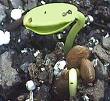
THIS IS WHAT YOU WILL NEED:
 Seeds:
Seeds:
If you purchase seed packs read the directions on the back of the package as they will give you the details that help bring success like planting depth and any special consideration.
 Containers:
Containers:
You have a wide choice and you don’t have to spend much to have very good containers. Use recycled plastic pots from previous years, sterilized by soaking in a 10% bleach solution for 15 minutes and air dried. You can cut down milk cartons, cottage cheese containers, and margarine tubs, and punch holes punched in the bottom for drainage. Any container about 3” tall will work if you put provide drainage holes at the bottom. If you prefer large containers (they dry out more slowly) use a disposable aluminum pan with holes punched in the bottom (from a dollar store). Avoid clay pots as they dry out too quickly.
 Soil:
Soil:
Most gardeners prefer a soilless mix because it can be kept evenly moist and is free from weed seeds and fungal spores. You can buy it at local nurseries like Loews or Home Depot or you can make your own using ingredients available at those same stores. There are many recipes for such a mix but a very simple and effective one is:
1 part sphagnum/peat moss
1 part perlite
1 part vermiculite
You can also use 1:1 peat moss:perlite
These mix lack nutrients but seeds don’t need nutrients to germinate and emerge. They will, however, require fertilizer as they grow.
 Kitchen strainer for covering seed and applying sand.
Kitchen strainer for covering seed and applying sand.
 Sand:
Sand:
A bag of play sand will be more than adequate. A fine layer of sand will be sprinkled over the top of your freshly sown seeds to cut down on possible infection by “damping off”. Alternatively you can spray with a fungicide. Sand is easier and less expensive.
 Labels and an indelible writing implement. You can use plastic from any plastic container cut into strips, or plastic dinnerware. The knives are excellent for this use. Use a Sharpie pen or wax pencil for writing. You may think that this is unnecessary but trust me it is essential. You will not remember what you have planted where especially as you move the containers around to get the light once they have germinated.
Labels and an indelible writing implement. You can use plastic from any plastic container cut into strips, or plastic dinnerware. The knives are excellent for this use. Use a Sharpie pen or wax pencil for writing. You may think that this is unnecessary but trust me it is essential. You will not remember what you have planted where especially as you move the containers around to get the light once they have germinated.
 Pencil, chop stick, skewer, or dibbler for making trenches or holes in the soil.
Pencil, chop stick, skewer, or dibbler for making trenches or holes in the soil.
 Plastic bags or sheets for covering containers.
Plastic bags or sheets for covering containers.
STEP BY STEP PROCEDURE:
1. Fill your containers within ¼ inch of the top.
2. Wet the soil by placing the containers in a pan (aluminum pan from the dollar store is great) with 2-3 inches of warm water until the surface of the soil is moist (30 minutes or so).
3. Check the back of your seed packet for planting depth instructions. Make trenches or small holes (depending on the size of the seeds) about 1 inch apart with your dibbler. In general seeds should be sown at a depth equal to 1 or 2 times their diameter. Very fine seeds can be scattered on the soil surface and pressed into the soil with the bottom of a drinking glass.
4. Cover your seed with the specified amount of soil. Use a strainer for an easier and even application.
5. Put a very light coating of sand over the soil with the striner.
6. Place a lable with the name of the plant into the container. Position it so it can prop up the plastic in number 7.
7. Put your container in a plastic bag or cover with plastic.
8. Put in a warm place where the temperature is consistently about 70F. If you want to get fancy buy a special heating pad designed for this purpose. Do NOT place the container in direct sunlight.
9. Check your pots or containers every day to make sure that they have not dried out. If they look dry place the container in warm water until the soil looks moist again. NEVER water from above.
10. As soon as the first few seedlings emerge take the container out of the bag and place in light, but not direct sunlight. Gradually bring the container into the sunlight over a period of 3 or 4 days being sure that they do not dry out.
HINTS, SUGGESTIONS AND NOTES:
 Some seeds need special treatment before they will germinate, such as a soaking in warm water, a cold treatment in a refrigerator or freezer, or scarification (nicking the seed coat). Check the seed packet for this information.
Some seeds need special treatment before they will germinate, such as a soaking in warm water, a cold treatment in a refrigerator or freezer, or scarification (nicking the seed coat). Check the seed packet for this information.
 Germination may take from 5 days to many months with 14-21 days being most common. Check the back of the seed packet for this information.
Germination may take from 5 days to many months with 14-21 days being most common. Check the back of the seed packet for this information.
 If you use large containers group seeds with similar germination times together so you can remove the plastic at a time beneficial to all.
If you use large containers group seeds with similar germination times together so you can remove the plastic at a time beneficial to all.
